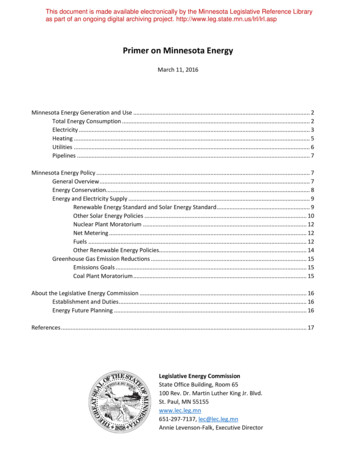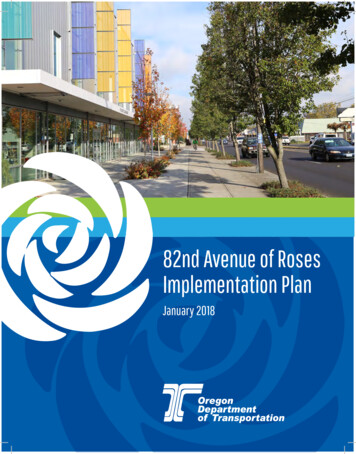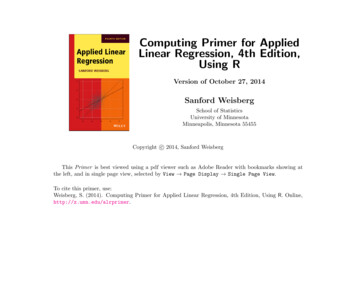
Transcription
This document is made available electronically by the Minnesota Legislative Reference Libraryas part of an ongoing digital archiving project. http://www.leg.state.mn.us/lrl/lrl.aspPrimer on Minnesota EnergyMarch 11, 2016Minnesota Energy Generation and Use . 2Total Energy Consumption . 2Electricity . 3Heating . 5Utilities . 6Pipelines . 7Minnesota Energy Policy . 7General Overview . 7Energy Conservation. 8Energy and Electricity Supply . 9Renewable Energy Standard and Solar Energy Standard . 9Other Solar Energy Policies . 10Nuclear Plant Moratorium . 12Net Metering . 12Fuels . 12Other Renewable Energy Policies. 14Greenhouse Gas Emission Reductions . 15Emissions Goals . 15Coal Plant Moratorium . 15About the Legislative Energy Commission . 16Establishment and Duties . 16Energy Future Planning . 16References . 17Legislative Energy CommissionState Office Building, Room 65100 Rev. Dr. Martin Luther King Jr. Blvd.St. Paul, MN 55155www.lec.leg.mn651-297-7137, lec@lec.leg.mnAnnie Levenson-Falk, Executive Director
Minnesota Energy Generation and UseTotal EnergyConsumptionFigure 1 shows total energy use in Minnesota by source. This includes energy used forelectricity transportation, heating, and all other purposes.More than half of energy is lost due to inefficiencies in its generation, delivery, and use.Much of this waste occurs in the form of heat escaping power plants and vehicle engines.The largest share of Minnesota energy is used in buildings (residential and commercial).About a quarter of total energy goes to transportation. However, because transportationfuel is relatively expensive, transportation accounts for half of spending on energy inMinnesota.2
ElectricityElectricity generationMinnesota wind generation has increased dramatically in the past decade, and coal’s portionof generation has declined by nearly the same amount.Minnesota natural gas generation is considerably lower than the national average. Naturalgas generation in Minnesota is largely used to back up wind power; gas generators rampdown when the wind is blowing and back up when more power is needed.Xcel Energy’s two nuclear plants, Monticello and Prairie Island, make up nearly 25% ofMinnesota’s generation. Their operating licenses expire in 2030 and 2033/34, respectively.iMinnesota solar generation, listed at zero in 2007, increased to 21,000 megawatt-hours(MWh) in 2014. This represents less than 1% of the total, but solar power is expected togrow rapidly in the next few years.2012-13 were anomalous because Unit 3 of Xcel’s Sherburne County (Sherco) plant was outof service until 2013, after suffering a massive failure in late 2011. A coal-powered generatorwith a capacity of 860 megawatts, Sherco 3 is Minnesota’s largest generating unit.ii Itsshutdown is reflected in the relatively lower share of coal power during these years.Utilities both own generation resources (power plants, wind farms, etc.) and buy power fromthird parties in power purchase agreements (PPAs). Some utility customers also own on-site3
generation, ranging from large industrial customers with combined heat and power facilitiesto residential rooftop solar photovoltaic. Regardless of whether a customer has on-sitegeneration, they almost universally remain connected to and dependent on the grid.Figure 5 shows only electricity generated in Minnesota; however, approximately 30% of theelectricity used in Minnesota is imported from other states or Canada.iiiThe grid and the Midcontinent Independent System Operator (MISO)Minnesota is part of a regional, national, and internationalFigure 6. Transmissionelectricity grid. In much of the U.S., regional transmissionand distributionorganizations (RTOs) exist to ensure the efficient and reliabletransmission of power. Minnesota is covered by an RTO calledthe Midcontinent Independent System Operator (MISO), anonprofit organization that coordinates electricity transmissionin an area from Manitoba to the Gulf of Mexico.MISO and other RTOs are comparable to air traffic controllersfor electricity. MISO does not own any wires or electricitygeneration, but it manages the transmission system,coordinates maintenance of generation and transmission, andplans for transmission expansion in order to ensure reliability.MISO works on the transmission level – the high-voltage linesthat carry electricity from where it’s generated. Minnesota’sdistribution grids – the lower-voltage local power lines – aremanaged by local utilities.MISO also operates competitive energy markets, on whichpower producers and utilities buy and sell electricity.Source: Dominion.“Comparison of Transmissionand Distribution Lines.”http://bit.ly/220DfP0. AccessedMarch 9, 2016.Participation in MISO is voluntary; utilities and power generators participate becauseregional coordination increases reliability and efficiency.Figure 7. Map of Regional Transmission OrganizationsSource: Federal Energy Regulatory Commission, rto.asp4
HeatingHeating fuel use varies greatlyby geography. Natural gas isthe most common source ofhome heating in Minnesota,but it is not available in allareas.These charts show primaryheating fuel for Minnesotahouseholds, though manyhouseholds use two or morefuels.Figure 9. Primary household heating fuel by county, 2010-2014Utility gasBottled, tank, or LP gasElectricityOther fuel** Other fuels include fuel oil,kerosene, wood, coke, orsolar energySource: U.S. Census Bureau. American Community Survey, 2010-2014 (5-year estimates).5
UtilitiesThere are three types of utilities in Minnesota: Investor-owned utilities (IOUs) are for-profit corporations and are regulated by thestate Public Utilities Commission (PUC). In statute, IOUs are called “public utilities”(not to be confused with municipal utilities, which are sometimes referred to as“public power”). Municipal utilities (munis) are nonprofit public entities. They are regulated by citycouncils or locally-appointed utility commissions. Municipal utilities mainly servesmaller population centers throughout the state, though munis also serve cities aslarge as Rochester. Cooperative utilities (co-ops or rural electric associations) are member-ownednonprofit organizations that serve rural areas. Co-op rates are governed by boardsof directors elected by their members, unless the utilities opt to have the PUCregulate their rates. (Only one co-op, Dakota Electric, has chosen to be PUC rateregulated). Co-ops cover 85% of the land area in the state but account for only 18%of retail electricity sales.ivElectric utilitiesMinnesota has a regulated electricity market, which means that electric utilities operate asmonopolies in their designated service territories. Your electricity provider is determined bywhere you live, and utilities are required to provide all of the electricity needed by everycustomer in their service territory. (Alternatively, some states allow for retail competition.)Minnesota utilities are vertically integrated, meaning that the utility owns all levels of thesupply chain – generation; transmission of bulk, high-voltage power; and distribution oflower-voltage power to end users. However, utilities also purchase electricity in powerpurchase agreements (PPAs) with independent generators, and they send power overtransmission lines owned by other organizations.Municipal and cooperative utilities split the roles of generation and transmission fromdistribution. Distribution utilities own and operate local power lines, and these are theentities that bill customers. Distribution utilities may own some generation themselves, butthey predominately purchase electricity. The electricity suppliers are called generation andtransmission utilities (G&Ts) on the cooperative side and municipal power agencies on themunicipal side. Great River Energy is Minnesota’s largest G&T cooperative; it provides powerto 28 member cooperatives.v Minnesota Municipal Power Agency, Southern MinnesotaMunicipal Power Agency, and several others serve municipal distribution utilities.Minnesota has: Four electric IOUs: Xcel Energy, Minnesota Power (Allete), Otter Tail Power, andNorthwestern Wisconsin Electric. 125 municipal electric distribution utilities. 45 cooperative electric distribution utilities.viNatural gas utilitiesUnlike electric utilities, natural gas utilities have no universal service obligation, and not allareas have gas service. It is not financially feasible to provide gas service to communities thatare located far from an interstate pipeline and do not have high population densities and/orlarge commercial or industrial customers. In some areas, pipelines are constrained bygeographic and environmental features, such as rivers, wetlands, forest, or rocky geologythat can’t practically be crossed.6
Minnesota’s natural gas distribution companies include: Five investor-owned utilities: CenterPoint Energy, Great Plains Natural GasCompany, Greater Minnesota Gas, Minnesota Energy Resources Corporation(MERC), and Xcel Energy.vii 31 municipal gas utilities.viii A number of small companies. Companies serving fewer than 650 customers on asystem, with fewer than 2,000 customers among all systems, are not required tobe regulated.ixThere are no cooperative natural gas utilities in Minnesota.PipelinesIn Minnesota, 65,000 miles of pipelines transport natural gas, propane, anhydrous ammonia,crude oil, and refined oil products, such as gasoline and diesel. These products are importedfrom oil and natural gas fields in North Dakota, Alberta, and other areas for use in state, andthey are pipe through Minnesota to customers in other states.Pipelines generally require two approvals from the Public Utilities Commission. A Certificateof Need determines the need for a large energy project, and whether the size, type andtiming of the proposed pipeline will meet that need. A route permit is required for pipelinesover 6 inches in diameter pumping hazardous liquids and pipelines designed to transportnatural gas at a pressure exceeding 275 pounds per square inch. Additional state and federalpermits may also be required, such as permits related to water quality. In its role as publicadvocate, the Department of Commerce’s Division of Energy Resources evaluates allpipelines requiring a Certificate of Need.xMinnesota Energy PolicyGeneral OverviewThe major areas of energy law are: Minnesota Statutes, Chapter § 216A: Public utility regulators Minnesota Statutes, Chapter § 216B: Public utilities Minnesota Statutes, Chapter § 216C: Energy planning and conservation Minnesota Statutes, Chapter § 216E: Electric power facility permits Minnesota Statutes, Chapter § 216F: Wind energy conversion systems Minnesota Statutes, Chapter § 216G: Pipelines Minnesota Statutes, Chapter § 216H: Greenhouse gas emissionsThe following sections provide more detail on some of the statutes that are frequentlydiscussed at the legislature. This is not comprehensive of Minnesota energy policy.Some of Minnesota’s energy policies are standards (or mandates), while others are goals.Generally, standards call for an entity or entities to be accountable for meeting certainrequirements, whereas goals set a policy directions for the state but hold no particularentities responsible for meeting targets.7
Energy ConservationEnergy Savings Goal (M.S. § 216C.05, subd. 2)Establishes a state goal of annual energy savings equal to at least 1.5% of annual retailelectricity and natural gas sales, to be achieved through cost-effective energy efficiency.Energy Conservation Improvement (M.S. § 216B.241)The Conservation Improvement Program (CIP) requires each utility to meet energy savingsgoals of 1.5% of annual retail sales per year. Utilities may request this goal be adjusted aslow as 1% per year based on their experience, customer types, and other factors, andutilities are not required to achieve the goal if it is not cost-effective. For electric utilities, atleast 1% energy savings must come from customer-side efficiency improvements; theremaining 0.5% may come from electric utility infrastructure projects.CIP also includes a requirement for minimum utility spending, but since the energy savingsrequirement was added in 2007, it is the savings requirement that drives utility action.xiSpending requirements are 0.5% of gross operating revenues for a natural gas utility, 1.5%for an electric utility, and 2% for a public electric utility that operates a nuclear plant (Xcel).Utilities meet their energy savings goals by offering Conservation Improvement Programs totheir customers, with incentives such as rebates on high-efficiency appliances, buildingenvelope improvements, and process efficiency upgrades. Utilities must offer low-incomeprograms and spend a minimum on these programs (0.2% of gross operating revenue for anelectric utility or a municipal gas utility; 0.4% for a public gas utility). Programs are approvedby the Department of Commerce. The Public Utilities Commission must allow the utilitiesthey regulate to recover their expenses related to the program plus a financial performanceincentive.Large customers may be exemptedfrom the Conservation ImprovementProgram – and from financialcontributions to the program – ifthey demonstrate that they aretaking conservation measures intheir facilities.According to a Department ofCommerce report, from 2007-2014,CIP saved more than 55 billionkilowatt-hours at a cost of 0.018 perkWh, and 206 trillion cubic feet ofnatural gas at 1.64 per million cubicfeet – significantly less than the costof electricity or gas that would haveotherwise been used. Combined,Commerce found the electric andnatural gas conservation programshad a net benefit of more than 3.4billion over this period.xii8
Energy and ElectricitySupplyRenewable Energy Objectives and Solar Energy Standard (M.S. § 216B.1691)The Renewable Energy Standard (RES) requires that each electric utility generate or procurea portion of their total retail electric sales from eligible renewable sources, increasingRenewable Energy incrementally until 2025 (see Figure 11). The RES applies to all Minnesota utilities and isStandard and higher and accelerated for Xcel, as the owner of nuclear generation. Eligible renewableSolar Energy Standard sources are: solar, wind, small hydroelectric (capacity of less than 100 MW), hydrogengenerated from a renewable resource, and biomass. Note that electricity from largehydroelectric dams does not qualify as renewable.Investor-owned utilities are also required to meet an additional solar energy standard (SES)of 1.5% by 2020, with at least 10% of that amount coming from small solar photovoltaicsystems (capacity of 20 kW of less). The SES was passed in 2013.Utilities are on track to meet the renewable energy standard. Twenty-one percent of theelectricity generated in Minnesota in 2014 was renewable, up from just 8% in 2007. Solarpower comprised less than 1% of generation in 2014 but is growing quickly, and progresstoward the SES will become clearer over the next couple years.Figure 11. Renewable electricity requirements, summarizedXcelOther IOUsNon-IOUs201015%201218%12%12%201625%17%17%2020 30% 1.5% solar20% 1.5% solar20%202525% 1.5% solar25%Renewable Energy Certificates (RECs): Once electricity is put onto power lines, there is noway to distinguish renewably generated electrons from any other power on the grid. For thatreason, renewable generation is measured with RECs. One REC represents theenvironmental attributes of one megawatt-hour of renewable power. Utilities demonstratethey are meeting the RES by retiring RECs. Utilities can get RECs from renewable generationthey own or purchase, or they can buy RECs from other power generators “unbundled” from9
power purchases. Tracking RECs prevents any unit of renewable power from being doublecounted even as the actual electricity may be bought and sold independently.The Department of Commerce submits an RES compliance report to the Legislature inJanuary of each odd-numbered year.Other Solar Energy Solar Energy Goal (M.S. § 216B.1691, subd. 2f)Policies Establishes a goal that 10% of retail electric sales in Minnesota be generated by solar energyby 2030.Made in Minnesota Solar Incentive Program (M.S.§ 216C.411-416) 15 million per year is available for 10 years for incentives to install Minnesota-made solarthermal or solar electric photovoltaic (PV) systems with a capacity of under 40 kW. 250,000of the total funds incentives for solar thermal systems, which convert sunlight directly tothermal energy for heating or cooling. The remainder goes to solar PV, which uses sunlight togenerate electricity.The incentive is financed from two sources:1. Investor-owned electric utilities contribute 5%of the minimum they are statutorily requiredto spend on energy conservation programs.2. The balance comes from Xcel’s RenewableDevelopment Fund.Owners of qualifying solar PV systems receive aproduction incentive (per kilowatt-hour generated) atamounts determined by the Department ofCommerce. The incentive amount is based on severalfactors, including the installed cost of the system, andmay be revised annually. The 2016 incentives rangefrom 0.13/kWh to 0.30/kWh depending on themanufacturer and whether the installation will beresidential, commercial for-profit, or taxexempt/nonprofit/government. Applicants enter alottery to receive incentives, and only electriccustomers of Xcel, Minnesota Power and Otter TailPower are eligible to apply. As of March 2016, fivemanufacturers have been certified for the program:tenKsolar, Silicon Energy, itek Energy, Heliene, andSaga Solar.xiiiThe solar thermal rebate amounts are set in statute:25% of the installed cost up to a maximum of 2,500for residential systems, 5,000 for multifamilysystems, and 25,000 for commercial systems. It isopen to utility customers throughout the state, withpreference given to customers of the investor-ownedutilities.10Figure 13. Solar PV systemsSource: tenKsolar, -KSolar AllianceProgramOverview ebook.pdf;Silicon Energy, http://silicon-energy.com/.Figure 14. Solar thermal systemsSource: RREAL, www.real.org
Community Solar Gardens (M.S. § 216B.1641)A community solar garden sells solar-generated electricity to subscribers who purchase aportion of its output. It allows access to solar energy by renters and property owners whocannot afford to install their own solar systems or whose property may be unsuitable for asolar installation. To date, community solar gardens have been most often owned by privatedevelopers, though some are utility-owned. Under this statute, which passed in 2013, XcelEnergy is required to have a community solar program; other utilities may offer programs bychoice.Xcel Energy’s program is required to purchase electricity from community solar gardens thatmeet certain criteria, including having a capacity of no more than one megawatt and havingat least 5 subscribers, with no single subscriber taking more than 40% of the garden’s output,and no subscriber purchasing more than 120% of their average annual electricityconsumption. The solar gardens can be owned by Xcel or any other entity that contracts tosell the electricity to Xcel. There is no limit on the number of generation capacity or solargardens in the program. Xcel’s community solar garden program must be approved by thePublic Utilities Commission.The number and cumulative capacity of gardens proposed for Xcel’s program to date has farsurpassed expectations. Xcel began accepting applications on December 12, 2014; by June23, 2015, it had received applications for projects totaling 912 MW.xiv The program has beenslow to start, as details were worked out in PUC proceedings, but is expected to be asignificant source of solar power in coming years.House Research published a brief with updates on Xcel’s community solar program inFebruary 2016: den.pdf.Value of Solar Tariff (M.S. § 216B.164, subd. 10)The value of solar (VOS) tariff is a per-kilowatt-hour rate that a public utility may use tocompensate its customers who have solar generation. The VOS is set according to a PUCapproved methodology that reflects the value that solar energy represents to the utility, itscustomers and society, incorporating savings that accrue from avoiding construction of newpower plants and transmission lines, reducing power line losses, and many other factors. Autility that uses the VOS tariff plugs the applicable values for its system into the approvedmethodology, resulting in a tariff that is unique to that utility.If a utility chooses the VOS tariff, customers with solar generation are charged the applicableretail rate for all electricity consumed, then given a bill credit for solar power generated atthe VOS rate. Utilities that use the VOS must recalculate it each year according to theestablished methodology – but the utility generally must contract with solar generators forat least 20 years, using the per-kilowatt-hour rate from Year 1 for the life of the contract.If a utility does not choose the VOS, customers with power generation are compensatedaccording to the net metering statute (see below). To date, no utility has elected to offer atariff based on the value of solar.11
Xcel Solar Energy Incentive Program (M.S. § 116C.7792)For five years beginning in 2014, Xcel Energy must provide production incentives for smallsolar energy systems. 5 million per year is allocated from the Renewable Development Fundfor this program. Qualifying solar energy systems have a capacity of no more than 20 kW, aresized to less than 120% of the customer’s on-site energy consumption, and are not receivingan incentive through the Made in Minnesota program. The incentive is paid for 10 years.Nuclear Plant Nuclear Plant Moratorium (M.S. § 216B.243, subd. 3b)Moratorium The Public Utilities Commission is prohibited from issuing a certificate of need for theconstruction of a new nuclear power plant. Any certificate of need for additional storage ofspent nuclear fuel for a facility seeking a license extension shall address the impacts ofcontinued operations over the period for which approval is sought.Net Metering Net Energy Metering (M.S. § 216B.164)“Net metering” is a method of compensating utility customers for electricity they generateand feed into the utility’s grid – for example, rooftop solar panels or a small wind turbine.Under net metering, the amount of electricity a customer generates is subtracted from theamount of power the customer uses, and the customer is billed for that net energy use.1Minnesota law provides for net metering of facilities up to 40 kW capacity for cooperativeand municipal utilities and up to 1,000 kW capacity for investor-owned utilities. If a customerproduces more electricity than they use, they are compensated at a rate reflecting theutility’s avoided cost that is set by the Public Utilities Commission or, for qualifying facilitiesunder 40 kW capacity, at the average utility retail rate.Cooperative and municipal utilities are permitted to charge an additional fee to recover fixedcosts not already paid for through a customer’s existing billing arrangement, under aprovision that passed in 2015. The fee must be “reasonable and appropriate” based on theutility’s most recent cost of service study, and this study must be made available for reviewby a customer upon request. This fee is intended to protect the economic health of utilitieswhen customers’ bills are less than the cost of electric service provided to their properties.This can occur because a portion of the utility’s fixed costs are covered by customers’ perkilowatt-hour electric rates, and customers’ power generation reduces their usage charges.Fuels Biofuel Content Mandate (M.S. § 239.791)Under this statute, gasoline for sale in Minnesota must contain either: The greater of (a) 10% conventional biofuel (derived from cornstarch) or (b) themaximum percent of conventional biofuel authorized by the U.S. EPA., or 10% of a non-conventional biofuel (not derived from cornstarch).Conventional biofuel must comprise no less than the portion specified below:July 1, 201390%January 1, 201580%January 1, 201770%January 1, 202060%January 1, 2025no minimum1Under the federal Public Utility Regulatory Policy Act (PURPA, 1978), utilities must purchase electricity from cogeneration facilities and fromfacilities with capacity of 80 MW or less that are primarily fueled by biomass or other renewables, waste, or geothermal.12
Biodiesel Content Mandate (M.S. § 239.77)With a few exceptions, diesel for sale in Minnesota for use in internal combustion enginesmust contain an increasing portion of biodiesel.September 29, 20052%May 1, 20095%May 1, 201210%May 1, 201820%The above minimums apply to April-September; in October-March, the minimum is 5%. Alower biodiesel content is used in colder months to avoid the fuel gelling.The above minimums become effective on the date specified only if the commissioners ofagriculture, commerce and pollution control publish a notice at least 270 days in advance;testing, supply and infrastructure needs have been met; and at least 5% of the necessarybiodiesel will be produced from a biological resource other than an agricultural resourcetraditionally grown or raised in Minnesota (for example algae, waste oil, or tallow).The 2012 increase went into effect in 2014. It was delayed due to inadequate blendinginfrastructure in the southwestern area of the state and inadequate regulatory protocol forMinnesota Weights and Measures enforcement.xvPetroleum Replacement Goal (M.S. § 239.7911, subd. 1)Establishes a goal that biofuel comprise an increasing portion of total gasoline for sale in ossil Fuel Reduction Goal (M.S. § 216C.05, subd. 2)Establishes a goal of reducingFigure 15. Fossil Fuel Use Per Capitaper capita fossil fuel use 15% by3502015. The statute does notMinnesotaUnited Statesspecify a baseline year, but it300passed in 2007.25020015014.7% reductionfrom 20071005002005 2006 2007 2008 2009 2010 2011 2012 2013Source: LHB, Inc., from U.S. Energy Information Administration. “Table CT3.Total End-Use Energy Consumption Estimates, 1960-2012, m?incfile /state/seds/sep use/tx/use tx MN.html&sid MN13
Other Renewable Renewable Development Fund (M.S. § 116C.779, subd.1)Energy Policies Xcel Energy must set aside money for the Renewable Development Fund (RDF) each year inexchange for storing spent nuclear fuel: 500,000 per dry cask stored at its Prairie Islandnuclear plant and 350,000 per dry cask at its Monticello plant. When the nuclear plants areno longer in operation, the Public Utilities Commission can require Xcel to contribute 7.5million (for Prairie Island) or 5.2 million (for Monticello) per year if it finds that Xcel has notmade a good faith effort to remove the spent fuel to a site out of state. As of August 2014,Xcel stored 38 casks at Prairie Island and 15 casks at Monticello; it plans to eventually store64 and 30, respectively.xviThe RDF can provide funds for the following purposes: To increase the market penetration wit
Four electric IOUs: Xcel Energy, Minnesota Power (Allete), Otter Tail Pow er, and Northwestern Wisconsin Electric. 125 municipal electric distribution utilities . 45 cooperative electric distribution utilities. vi Natural gas utilities Unlike electric utilities, natural gas utilities have no universal service obligation, and not all










